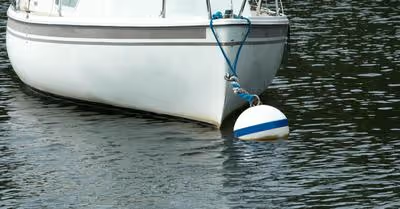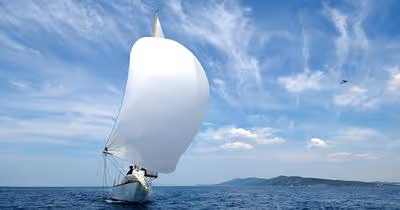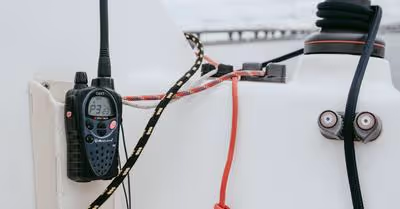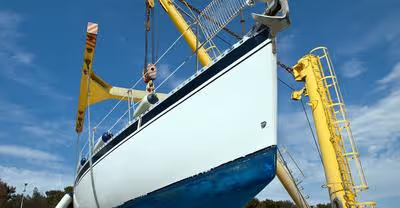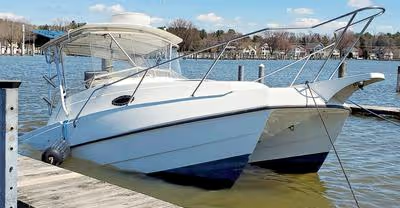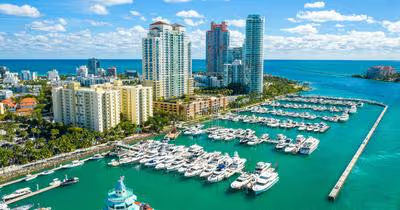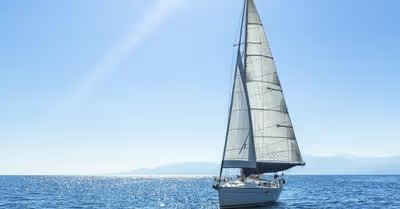Table of Contents
Priority Items You Need
When sailing full-time, it is easier to break down items into separate categories based on the level of importance. These categories are priority items that should be mandatory, somewhat important items that are essential and other items that can be argued whether or not it makes your life easier.
Communication Devices
Having a way to communicate with your family is desirable, but you need something else to communicate with in case of an emergency. A marine radio or satellite phone is a great place to start.
Marine radios will have specific channels to speak to someone in the event of an emergency or traffic conditions. Having a single-sideband radio will be ideal if you plan on sailing beyond the reach of other types of radios.
As for satellite phones, these are excellent options for communication. Finding a high quality satellite phone will not be cheap, but you can rest assured it will be there if any emergencies occur.
Safety Equipment
The Coast Guard has strict requirements that all boaters need to follow. To sum it up, you will need proper flotation devices, fire extinguishers, visual distress signals, and functioning lights.
Having life jackets seems like a no-brainer, but it is important to emphasize safety. There will be times when you are alone at sea, so you only have yourself or your crew to rely on safely to your next destination.
Fire extinguishers, even though you are on the water, are especially important. You never know when a grease fire or electrical fire can occur, so you need a way to properly put it out.
Visual distress signals are the first step in getting help in showing your location to passing boats. These could be flares, an electronic signal, or parachute flares.
You will need lights on your boat if they are not already equipped. Most importantly, these locations of lights are on the masthead, side, and stern.
A white light needs to be placed on the centerline of the head of the boat. As for the sides, a red light on the port (left) and green on the starboard (right).
A white light on the stern needs to be used anytime at night or while anchoring. In addition, it never hurts to have a few extra white lights if you have a larger boat.
In addition, you will run into situations where heavy fog or visibility is bad. Having an air horn or another form of a sound device is important in those situations.
Finally, a first aid kit or some package containing all the essentials for cleaning up cuts or other injuries is crucial. It does not have to carry an entire hospital in a bag, just the basics like bandages, over-the-counter pain medication, and even disinfectants.
Charts and Navigational Tools
Living on a sailboat means you are going to need navigation supplies. Think of charts, chart plotting tools, navigational systems like GPS, and even a compass.
Thanks to technology, you can safely navigate in areas unknown to you with the use of GPS and charts. In the event that your systems are not working properly or you want to explore a specific area, reading your charts will be key to succeeding.
Eating and Cooking
Fishing might be a lifesaver if you can effectively catch and clean your fish to eat. However, this might take up more room than you want on a daily basis.
Cooking space is limited, so you will need to utilize the area to the beach of your ability. This means smaller cookware and smaller portions of food at a time.
Storing food can be a task too, especially with challenges from energy consumption to run the refrigerator and the space needed in it. Having non-perishables and canned food might be the route you take often.
Water Systems for Drinking
This goes hand in hand with eating, but you need to safely drink water. With days out at sea, running out of water could be the difference between life and death.
Having a watermaker or desalinator is going to slowly keep your water supply in check. This will allow you to filter saltwater from the ocean to be able to drink.
Watermakers can be a bit pricey depending on the brand and size that you choose. Having one of some kind is going to make a huge difference.
You may also want to consider extra potable water storage on your boat. Having an emergency stash of drinking water in the event that your water maker messes up could be huge in this situation.
Tools for the Job
You do not have to bring every tool you own to live on a sailboat. Even though you are living full time on it, it would be nearly impossible to bring every tool for things you are likely never to fix while at sea.
Prioritize your tools to simpler things like a screwdriver, wire cutter, hammer, pocket multi-tool, pliers, saws, wrench set, and even clamps. In addition, flashlights, duct tape, extra drain plugs, and a small hatchet could come in handy.
Having extra nuts, bolts, or screws that are specific to your sailboat is important if things become lost or damaged. You do not have to go overboard with how many you need here, but a few to carry you over to the next destination would be ideal.
Experience a Big Factor
If this is the first time you are sailing or thinking about living aboard a sailboat, you might want to gain more experience first. Depending on the person, it might take some time to properly operate your boat and get used to harsh conditions at sea.
Starting small would be ideal, like weekend trips or a month away from the harbor to see if you like it. This way you are not fully committing out where you are uncomfortable or rookie mistakes might cause you to put your life at risk.
Secondary Items of Importance
While priority items due to safety and eating make sense for most people, there are additional items you are likely to need on your travels at sea. These items are potentially a priority to some, but it is up to you to consider what works best for your situation.
Cleaning Supplies
This is going to vary from one person to the next, but think about what cleaning supplies you are likely to use. You will be cleaning nearly every surface of the boat that is tracked, sat, or eaten on.
Organizing your living space will help cut down on unnecessary things blocking your path. This will also help keep your boat clean and safe to move around.
If your boat is large enough, you might consider having a mop that can handle the galley and main deck. Smaller boats might be better to just wipe down surfaces with heavy-duty wipes.
Cleaning and sanitizing sprays are going to be used, especially since mold is one of your biggest threats at sea. Cleaning sprays for windows, or at least a multi-surface cleaner is another good one to carry with you.
In addition to cleaning sprays, your boat is going to get dirty. The outside of the boat will need to be scrubbed at least once a month, but the walkways and handrails need to be cleaned regularly to avoid the build-up of mold or other forms of slippery conditions.
A handheld vacuum might also come in handy with the amount of dust and debris you create. However, charging one of those might be limited if you do not have a way to charge it.
Surfaces are not the only thing that needs to be cleaned. The grey and black water tanks need to be checked every so often.
Greywater tanks, for washing hands and showers, need to be cleaned but you cannot physically get your hands in them. You will need to find a marine quality cleaner that you can pour down the drain to prevent grease buildup.
As for black water tanks, this is all human waste. You will need to thoroughly flush this out and potentially use a marine quality detergent to help break down the solids.m so your tank does not clog.
When looking into a marine quality cleaner or detergent, this is subject to whatever your sailboat is equipped with. This means your sailboat might have a way to store waste differently than other boats, as categorized by Type I, Type II, or Type III MSD (Marine Sanitation Device).
Hookups at Marinas
When you have the opportunity to hook up at a marina, you will need three things. These include a heavy-duty power supply, lines to tie off your boat, and a quality water hose that is safe to drink from.
You might not use your lines too often, but having some made-up and ready-to-go are important if you need to leave your boat in a hurry. Hooking up to shore power is crucial to recharging your batteries if your solar panels are struggling. For freshwater hoses, you want one that is safe to drink like an FDA or NSF hose that does not have any harsh chemicals laced in the hose.
In addition, some marinas are equipped to handle sewage. These are pump-out systems, but not every marina has them.
Cosmetic Touch-Ups
In addition to cleaning your boat, it would not hurt to carry some extra paint brushes, paint, wood stain, and sandpaper to clean up the look of your sailboat while you live on it. You are going to have dings, cuts, and areas that need to be patched from time to time.
Routine cosmetic work is going to be essential for the long-term health of your sailboat. This will also protect your boat from rust and rot, which will help you save a ton of money in the long run.
Having some spare fiberglass sheeting and resin would not be a bad idea to keep around either. If you damage areas of the boat, you are going to want to take care of that promptly.
Marine epoxy resin and fiberglass will help restore cracks and repair leaks. This is a must-have combination if you plan on being away from the harbor for long periods of time.
Solar Power for Everything
What better source of energy than the sun right at your fingertips. Using solar power is one of the best resources you can have while being exposed full time at sea.
Having your boat equipped with solar panels will help keep your batteries charged and use less energy in other areas like your refrigerator. There are a few unique uses where you can get creative with solar power, such as:
- Solar deck showers
- Solar oven
- Solar device chargers
You could also look into utilizing wind power to help supply energy to your boat. You would need to consider the costs of installing a wind generator and how it would help your situation.
Shade from the Sun
Since you are looking into utilizing the sun for its power, it would be wise to cover your body in proper attire in order to protect yourself from the sun's rays. This means you need to either wear the right clothing, spray a lot of sunscreens, or use a cockpit canopy.
Cockpit canopies are similar to the material you might see for a soft dodger, which is a barrier that covers you from wind, water, and debris when operating the boat. These canopies are useful in protecting you from the sun and light rain when casually sailing about.
As for clothing, you want something that is going to be comfortable and lightweight but also protects you from the sun. Clothing that has UPF protection or is similar to what professional fishers use is a good start. In colder weather, you might consider a base layer or a jacket that will block out the wind.
A Kettle for Water
This could be categorized into the food and water section, but most people might think of a kettle simply to boil water for noodles or for a cup of tea. However, a kettle can be utilized in another way.
Boiling water lets off steam, which then can be used and collected for drinking water. The beauty of this is that you can use seawater or freshwater that you might not trust before boiling.
Clothespins
There will be times when you are away at sea and you need to do laundry. Washing things quickly in the sink is a quick fix when you are not near any marine ports that have washing facilities.
Drying these articles of clothing will be interesting, especially if you try them outside with the wind. Using a few clothespins to hold clothing down will help dry them and hold onto them.
Recent Articles




